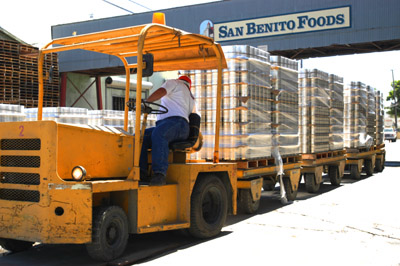Opened in 1915 by Frank Felice, and at that time known as the
Hollister Canning Company, the local plant was among the first of
its kind to exist in the county. And now, owned by San Benito
Foods, it is the last to remain.
Opened in 1915 by Frank Felice, and at that time known as the Hollister Canning Company, the local plant was among the first of its kind to exist in the county. And now, owned by San Benito Foods, it is the last to remain.
Every day during the summer canning seasons throughout the early 20th century, horse-drawn wagons continuously carried in tomatoes from the local fields. Workers started the boilers. Whistles screeched. And locals would trudge on foot from nearby homes to process tomatoes.
The cannery, through generations of sweeping changes to Hollister’s physical and cultural landscape, has been operating steadily since its construction 88 years ago.
A series of companies have owned the cannery since it began. The Felice family sold it to the Royal Canning Company in the 1960s, which subsequently sold it to the Contadina Canning Company.
San Benito Foods purchased the plant in 1977. And since 1991 when Tri-Valley Growers left town, it has been the area’s only cannery.
The City of Hollister and the cannery maintain a long-standing relationship. For 30 years, the city has allowed temporary blockage of several streets near the plant. And since 1972, the cannery has used the industrial wastewater plant for its multi-million-gallon disposal during the 10- to 12-week peak season.
While other canning companies packed-up long ago, San Benito Foods has expanded, according to plant officials. It cans more than 100 different tomato-related products.
City planners have speculated in recent years whether the cannery will remain in Hollister.
“The rumor mill is rampant,” said Al Martinez, director of the Economic Development Corp.
Regardless, Martinez said San Benito Foods continues to leave a positive imprint on the local economy.
“It has a tremendous impact on this county,” he said.










